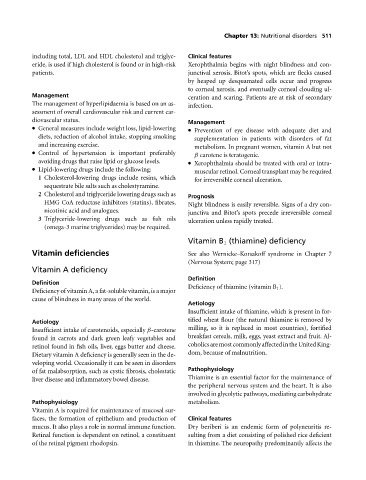Page 515 - Medicine and Surgery
P. 515
P1: KOA
BLUK007-13 BLUK007-Kendall May 13, 2005 16:24 Char Count= 0
Chapter 13: Nutritional disorders 511
including total, LDL and HDL cholesterol and triglyc- Clinical features
eride, is used if high cholesterol is found or in high-risk Xerophthalmia begins with night blindness and con-
patients. junctival xerosis. Bitot’s spots, which are flecks caused
by heaped up desquamated cells occur and progress
to corneal xerosis, and eventually corneal clouding ul-
Management ceration and scaring. Patients are at risk of secondary
The management of hyperlipidaemia is based on an as- infection.
sessment of overall cardiovascular risk and current car-
diovascular status. Management
General measures include weight loss, lipid-lowering Prevention of eye disease with adequate diet and
diets, reduction of alcohol intake, stopping smoking supplementation in patients with disorders of fat
and increasing exercise. metabolism. In pregnant women, vitamin A but not
Control of hypertension is important preferably β carotene is teratogenic.
avoiding drugs that raise lipid or glucose levels. Xerophthalmia should be treated with oral or intra-
Lipid-lowering drugs include the following: muscular retinol. Corneal transplant may be required
1 Cholesterol-lowering drugs include resins, which for irreversible corneal ulceration.
sequestrate bile salts such as cholestyramine.
2 Cholesterol and triglyceride lowering drugs such as Prognosis
HMG CoA reductase inhibitors (statins), fibrates, Nightblindness is easily reversible. Signs of a dry con-
nicotinic acid and analogues. junctiva and Bitot’s spots precede irreversible corneal
3 Triglyceride-lowering drugs such as fish oils ulceration unless rapidly treated.
(omega-3 marine triglycerides) may be required.
Vitamin B 1 (thiamine) deficiency
Vitamin deficiencies See also Wernicke–Korsakoff syndrome in Chapter 7
(Nervous System; page 317)
Vitamin A deficiency
Definition
Definition
Deficiency of thiamine (vitamin B 1 ).
Deficiency of vitamin A, a fat-soluble vitamin, is a major
cause of blindness in many areas of the world.
Aetiology
Insufficient intake of thiamine, which is present in for-
tified wheat flour (the natural thiamine is removed by
Aetiology
Insufficient intake of carotenoids, especially β-carotene milling, so it is replaced in most countries), fortified
found in carrots and dark green leafy vegetables and breakfast cereals, milk, eggs, yeast extract and fruit. Al-
retinol found in fish oils, liver, eggs butter and cheese. coholicsaremostcommonlyaffectedintheUnitedKing-
Dietary vitamin A deficiency is generally seen in the de- dom, because of malnutrition.
veloping world. Occasionally it can be seen in disorders
of fat malabsorption, such as cystic fibrosis, cholestatic Pathophysiology
liver disease and inflammatory bowel disease. Thiamine is an essential factor for the maintenance of
the peripheral nervous system and the heart. It is also
involved in glycolytic pathways, mediating carbohydrate
Pathophysiology metabolism.
Vitamin A is required for maintenance of mucosal sur-
faces, the formation of epithelium and production of Clinical features
mucus. It also plays a role in normal immune function. Dry beriberi is an endemic form of polyneuritis re-
Retinal function is dependent on retinol, a constituent sulting from a diet consisting of polished rice deficient
of the retinal pigment rhodopsin. in thiamine. The neuropathy predominantly affects the

